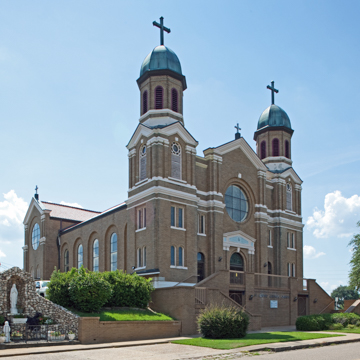The first Catholic church in Texarkana, Sacred Heart, was built on the Texas side in 1874 on land donated by the Texas Pacific Railroad. In 1903 parishioners living on the Arkansas side of town petitioned Bishop Edward Fitzgerald to form a church of their own. For the first few months Mass was held in a courtroom in the Miller County Courthouse until the first church, a fame Gothic Revival edifice, could be completed. Some twenty years later, the present church, clad in brown brick with limestone trim, was constructed under the supervision of de Konning, an architect and builder as well as a member of St. Edward’s. Raised on a high basement and reached by a steep, divided staircase, the church soars over the surrounding neighborhood. Augmenting its verticality and dominating the balanced facade are twin hexagonal towers capped with domical roofs. Hints of a Renaissance Revival mode are seen in the round-arched windows and the wide pediments carried on narrow pilasters that appear over the main doorway, crowning the central section, and on the towers. A prominent limestone stringcourse wraps the entire building, countering the towers’ verticality. Many of the interior appointments are original and of exceptional quality, including several stained glass memorial windows, the twenty-one-foot-high altar, and the communion rail of Carrara marble inset with mosaic bands. A new entrance foyer with elevator was added on the north side in 1996. St. Edward’s congregation made a deliberate outreach to the Vietnamese who settled in the area in the 1970s; a similarly successful outreach to Hispanics in the early 1990s has resulted in a vibrant multiethnic church community.
You are here
St. Edward Catholic Church
If SAH Archipedia has been useful to you, please consider supporting it.
SAH Archipedia tells the story of the United States through its buildings, landscapes, and cities. This freely available resource empowers the public with authoritative knowledge that deepens their understanding and appreciation of the built environment. But the Society of Architectural Historians, which created SAH Archipedia with University of Virginia Press, needs your support to maintain the high-caliber research, writing, photography, cartography, editing, design, and programming that make SAH Archipedia a trusted online resource available to all who value the history of place, heritage tourism, and learning.















